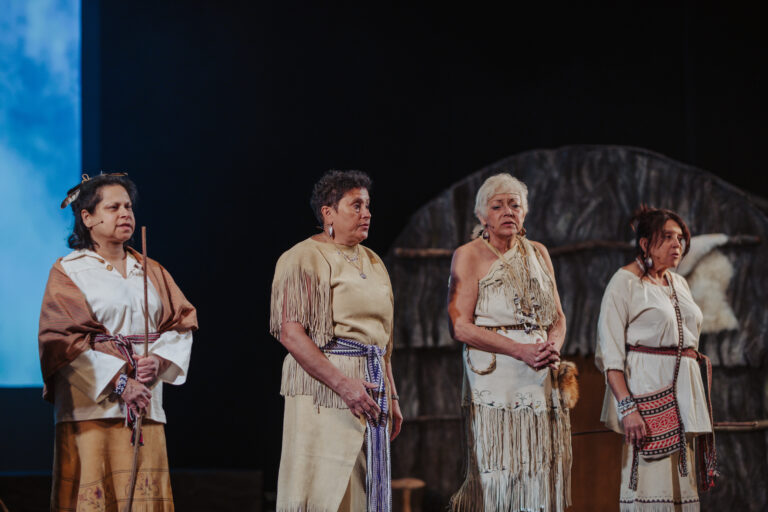Presented by ArtsEmerson
Written, created, and performed by members of the Wampanoag Nation
Featuring: Aiden Andrews, Nelson Andrews Jr., Siobahn Brown, Melvin Coombs, Troy Currence, Hartman Deetz, Jasmine Goodspeed, Audreyana Sterling Harding, Kitty Hendricks, Stephen Hendricks, Vanessa Mendes, Asa Peters, Jim Peters, Paula Peters, Michelle St John, Carol Wynne
Originally produced by the Wampanoag Nation for performance at Theatre Royal Plymouth, UK
September 29 & 30, 2023
Emerson Cutler Majestic Theatre
219 Tremont Street Boston
Boston, MA 02116
Running time: 1 hour 15 min approx
Statement by Kitty Drexel
Review by Noelani Kamelamela
BOSTON, Mass. — ArtsEmerson presents We Are the Land. It is an historical account of colonization by the Wampanoag Nation for all audiences on September 29 and 30 at the Emerson Culter Magestic Theatre in Boston.
It is my great privilege to serve the New England theatre community as a critic. Sometimes, as is the case of We Are the Land, it is my duty to serve as a historian and then step aside to make room for other voices. In a moment, I will cede space to Noelani.
The Wampanoag Nation’s storytelling must not be judged by white, European theatre and dramaturgy standards. The significance of their personal and cultural survival is far more important than the arbitrary rules of white theatre. We must look beyond our preconceived notions of “good theatre” to champion effective storytelling instead.
Having a land acknowledgment, and serving that statement means prioritizing acts of service to New England indigenous communities. It is not enough to have a land acknowledgment. Theatres must make good on their statements with acts of service. Believing indigenous lives matter means acting to prove a land acknowledgment is more than lip service.
More predominantly white theatres should follow ArtsEmerson’s example to serve their indigenous communities by ceding space, time, and money to indigenous stories and art. Let more white theatres put their money where their mouths are and support the works of indigenous artists. Do it seasonally, transparently, and purposefully, until justice has been served – whenever that may be. – Kitty
///
Commentary and review by Noelani Kamelamela
BOSTON, Mass. — The first time I heard a Land Acknowledgement spoken out loud by a white person, I was visiting Australia. As a Kanaka Maoli, I learned a bit about Aboriginal history, although it was mostly filtered through a simplified Eurocentric lens.

Elders. Photo by Don Moore Photography.
I experienced a mix of feelings, but I was surprised by an overwhelming sense of rightness. To hear harmful colonialist history spoken out loud without any caveats, presented as fact without embellishment was exciting and also a little scary.
Years later, my own workplace is looking into creating an official Land Acknowledgement statement and we are as a nation two years away from the acceptance of Indigenous People’s Day by our federal, state, and local city governments here in Massachusetts.
I am impressed that the average American is now reckoning with our collective history in a post-George Floyd world, but it has to be acknowledged that Native Tribes and Indigenous Folks have had to carry their truths, both difficult and joyful, unseen by the average American. Land Acknowledgements can feel hollow to hear from CEOs actively working to pollute our public and Native Lands, or from companies that discriminate according to race and ethnic affiliation. As someone who has lived in Massachusetts for a while, it’s not a simple or easy thing to learn about other Native people without worrying that I was hearing a sanitized version of history and culture.
I was excited to come to this special presentation. I had, as someone who knows a bit about my own people’s stories, prepared myself emotionally for what I experienced negatively at “We Are The Land.” If you are triggered by casual and overt racism, mentions of intentional and unintentional genocide, or hearing the name of the 45th US President, then brace yourself.
Most pleasantly, there was a sense of community amongst the audience, in custom and dress, before the official start and a reading of a Land Acknowledgement from a leader at ArtsEmerson, also a Native American. While the setup of the stage remained static throughout the performance, the center of the action was always meant to feel like the spiritual center of a village, where members participate in ceremonies, entertainment, and sharing important news. Appropriately, the first scene appeared to be night in the moments before dawn.
With a runtime of 75 minutes, Wampanoag performers embodied through mime, costume, spoken dialogue, and song, the Wampanoag stories through 400 years, from slightly pre-Western contact to the present day. Local non-Wampanoag actors also rounded out the ensemble.
No Wampanoag actors portrayed Westerners; no Westerners embodied a Wampanoag person. Every story felt selected with different emotional beats, and all pieces were accentuated by projected images and music that played over the sound system.
The final scene was carried by each Wampanoag player onstage stating their own personal journeys. The diversity within those tales was also breathtaking. I witnessed a beginning for myself, where the words of an Acknowledgement are also an invitation to learn and not just reflect. It was a community ritual, as most theatre is, to tell universal stories.
When I hear the words now, I can bring to it what I now know from the point of view of living members of the Wampanoag Nation. I left feeling excited because the people alive are still a part of their homeland and each other’s regard.
